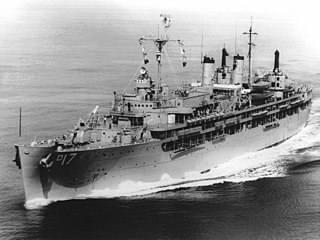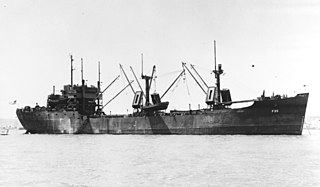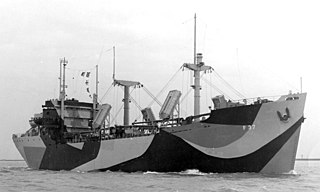
USS McGinty (DE-365) was a John C. Butler-class destroyer escort of the United States Navy.

USS Platte (AO-24) was a Cimarron-class oiler serving with the United States Navy, named for the 1836 Platte Purchase that included the Platte Rivers in Iowa, Missouri and Nebraska. Her memorial in Platte County, Missouri honors all four rivers that share the name recorded by Lewis and Clark in 1803.

USS Graffias (AF-29), a Hyades-class stores ship, is the only ship of the United States Navy to have this name. The name Graffias is another name for the star Beta Scorpii in the constellation Scorpius.

USS Leo (AKA-60), an Andromeda-class attack cargo ship, was named for the constellation Leo. She is the only ship of the United States Navy to hold this name. USS Leo served as a commissioned ship for 10 years and 5 months.

USS Piedmont (AD–17) was a Dixie-class destroyer tender built during World War II for the United States Navy. Her task was to service destroyers in, or near, battle areas and to keep them fit for duty. She served in the Pacific Ocean during World War II, the Cold War, the Korean War, and the Vietnam War. For her work in battle areas, the ship was awarded four battle stars for her Korean War efforts and one for Vietnam War service.

USS Hector (AR-7) was a repair ship that served in the United States Navy from 1944 to 1987 and as PNS Moawin in the Pakistan Navy from 1989 to 1994.

A Service Squadron (ServRon) was a United States Navy squadron that supported fleet combat ships and US Navy Auxiliary ships. Service Squadrons were used by the US Navy from their inception in 1943 to as late as the early 1980s. At the time of their inception during the Second World War they allowed the US Navy to operate across the vast reaches of the Pacific Ocean for extended periods of time. Service Squadrons created temporary forward bases to allow the naval squadrons to spend less time in transit and more time in the area of combat. Ulithi, a small volcanic atoll in the central Pacific, is an example of a site converted for use as a forward base of supply. Service Squadrons essentially created a major naval base near the area of operation. With naval bases like, Naval Base Ulithi, to refit, repair and resupply, many ships were able to deploy and operate in the western Pacific for a year or more without returning to a major port facility. Among the vessels operating in service squadrons were tankers, Fleet oilers, refrigerator ships, ammunition ships, supply ships, floating docks and repair ships. They provided diesel, ordnance, aviation fuel, food stuffs and all other supplies. Equally important at places like Ulithi were the portable piers and floating dry docks which allowed many ships damaged by enemy action or Pacific storms to undergo repair without having to travel the thousands of miles back to a major US naval base. Ulithi was as far forward from the US naval base at San Francisco as the San Francisco base was from London, England. To have a fully functional major port in the middle of the Pacific was a significant aid to U.S. Navy operations.

USS Outagamie County (LST-1073) was an LST-542-class tank landing ship in the United States Navy. Unlike many of her class, which received only numbers and were disposed of after World War II, she survived long enough to be named. On 1 July 1955, all LSTs still in commission were named for US counties or parishes; LST-1073 was given the name Outagamie County, after Outagamie County, Wisconsin.

USS Dionne (DE-261) was an Evarts-class destroyer escort of the United States Navy during World War II. She was sent off into the Pacific Ocean to protect convoys and other ships from Japanese submarines and fighter aircraft. She performed escort and antisubmarine operations in dangerous battle areas and returned home with six battle stars, a high number for a ship of her type.

USS Hickman County (LST-825) was an LST-542-class tank landing ship built for the United States Navy during World War II. Named after counties in Kentucky and Tennessee, she was the only U.S. Naval vessel to bear the name.

USS Safeguard (ARS-25) was a Diver-class rescue and salvage ship in service with the United States Navy from 1944 to 1947 and from 1952 to 1979. She was then transferred to Turkey where she served as TCG Işın (A-589) until 2017.

USS Hyades (AF-28) was the lead ship of her class of stores ships acquired by the U.S. Navy for service in World War II. Her task was to carry stores, refrigerated items, and equipment to ships in the fleet and to remote stations and staging areas.

USS Adria (AF-30) was an Adria-class stores ship in service with the United States Navy from 1944 to 1954. She was scrapped in 1977.

USS Karin (AF-33) was an Adria stores ship in service with the United States Navy from 1945 to 1958. She was into commercial service in 1969 and was scrapped in 1987.

USS Kerstin (AF-34) was an Adria class stores ship in service with the United States Navy from 1945 to 1950.

USS Latona (AF-35) was an Adria-class stores ship in service with the United States Navy from 1945 to 1949. She was scrapped in 1973.

USS Malabar (AF-37) was an Adria-class stores ship in service with the United States Navy from 1945 to 1955. She was scrapped in 1977.

USS Palisana (AF-39) was an Adria stores ship stores ship acquired by the U.S. Navy for service in World War II. Her task was to carry stores, refrigerated items, and equipment to ships in the fleet, and to remote stations and staging areas.

USS Tombigbee (AOG-11) was a Patapsco-class gasoline tanker in service with the United States Navy from 1943 to 1972. She was then sold to Greece, where she served as Ariadni (A414) until 2003.

USS Knudson (APD-101), ex-DE-591, later LPR-101, was a United States Navy high-speed transport in commission from 1944 to 1946 and from 1953 to 1958.




















